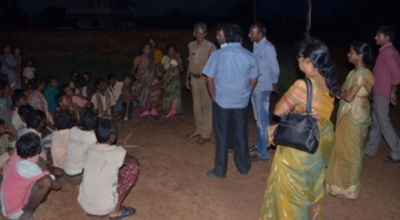Nearly 70 ‘Slaves,’ Including 35 Children, Rescued in Rural India
Nearly 70 people were rescued from a life of slavery in a rural district in Andhra Pradesh recently. Children were forced to work beside their parents in a brick factory around the clock—literally up to 22 hours a day, seven days a week. One 10-year-old boy told how he had to make 2,000 clay bricks a day, carrying eight at a time.
The 21 families were trapped inside the factory. No one was allowed to leave, and they earned about a quarter a day (14 rupees). The women had one hour a day to cook food for their families. They ate the same meal of rice and tomato for every meal.
Over the course of their five months in captivity, the slaves’ sense of “self” started to disintegrate. Family structures started to corrode. Husbands and wives were forced to sleep separately. Parents watched helplessly as their toddlers were forced to turn over the bricks under the hot sun, making sure they dried evenly.
On April 18, International Justice Mission (IJM) gave evidence to state-level government officials that documented the alleged abuse inside the brick factory. The government assembled a rescue team and drove to the factory. It was raining when they arrived, and the families were huddled together under a makeshift shelter.
IJM helped the families gather their meager belongings and then escorted them back to the government office. Most of the men and women answered questions devoid of emotion, simply stating the facts of their reality. It was clear they had been trapped in the brick factory as forced labor slaves, held there by violence and fear.
One woman cradled her malnourished infant in fragile arms as she told the government officials about the harrowing delivery of the infant three months earlier. She gave birth to the baby all by herself. She said the owner refused to let a midwife or any other workers help her. After much pleading, the owner finally relented and allowed her mother-in-law to go cut the umbilical cord and wash the baby. The woman went on to say that her husband had run away from the factory after enduring severe physical abuse.
“The amount of violence and physical abuse faced by the laborers was life-threatening,” according to IJM Chennai Director of Casework Alice Suganya. She adds, “All of the men said they had been beaten or harassed. They told us how the owner even abused the toddlers that asked for breast milk.”
A teenage boy using a walking stick explained how he had gotten his injury inside the brick factory. He said the brick factory owner shoved him onto a pile of rocks, and he believed his leg was broken. He was never allowed to get treatment, and his leg still has not healed properly.
After hours of recording the group’s shocking stories of abuse, the government officials issued 44 release certificates. These legal documents emancipate the slaves and entitle them to government benefits, including monetary compensation.
The IJM staff on the scene made sure the families had a good meal, then helped them board a train that would take them home. The journey lasted 24 hours.
“There is a huge influx of migrant laborers to the southern states,” explains Anu George Canjanathoppil, director of Google interventions—an IJM project funded by Google to train and equip other NGOs and government officials on how to combat forced labor slavery throughout India.
Canjanathoppil adds that most of the slaves her team discovers are extremely vulnerable, “under debt and facing acute poverty.” They are easily lured across state borders with the promise of a steady job with room and board—plus a hefty payment up front. “Forced labor slavery is exactly this: a trap. The slave owners prey on impoverished people desperate to survive,” she says.
It is a new day for the 21 families rescued late last week. IJM will continue to follow up and make sure they have access to the resources they need to rebuild their lives in safety. Canjanathoppil’s team, working with partners in nine states across India, will continue to raise awareness and build capacity so the government can effectively end forced labor slavery.
“The issue is highly prevalent and requires attention from both state and central government,” she says.
Pray that God will continue to use IJM not only to rescue these victims physically, but also spiritually.














































